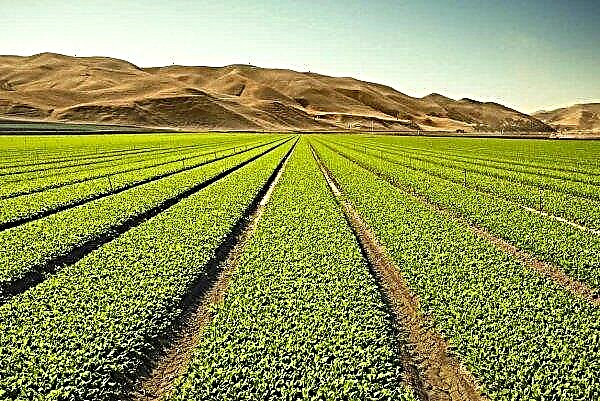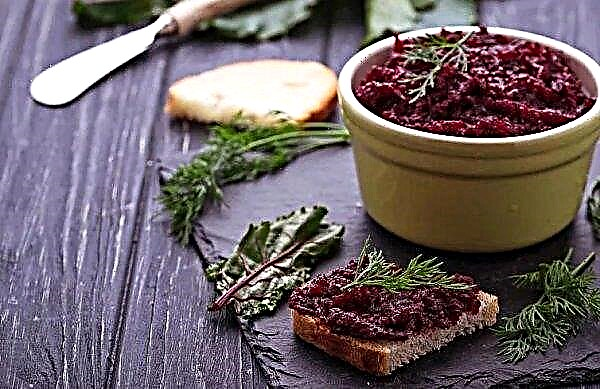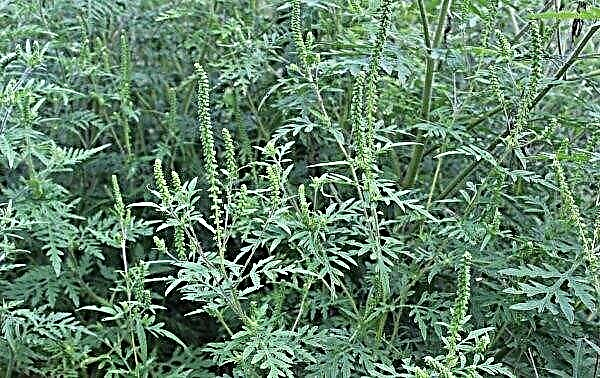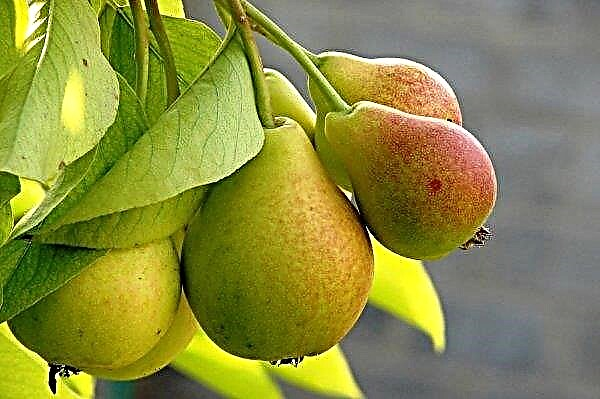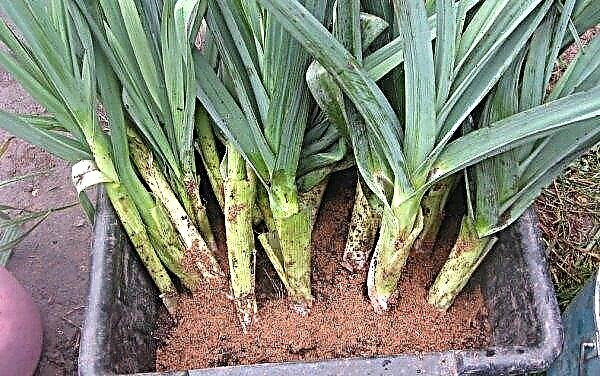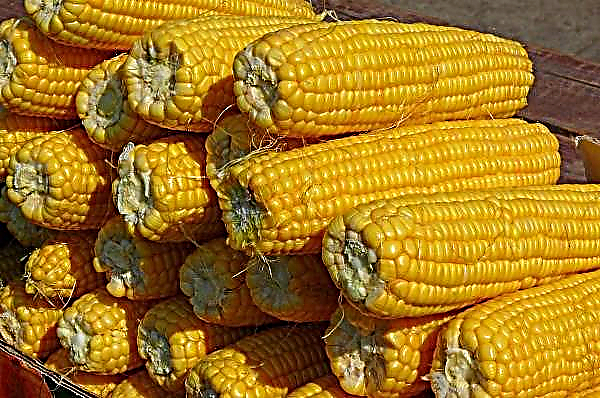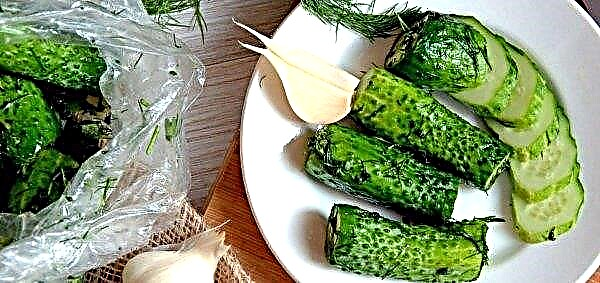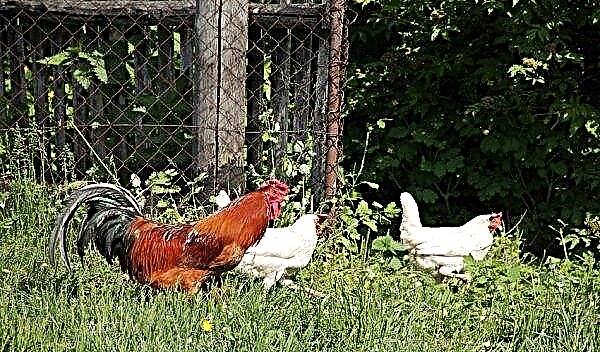In the expanses of the former Soviet Union, the American potato variety has long been well known. The consumer loves it for its loose consistency and excellent taste.
Description and characteristics of the variety
The correct name for the variety is Early Rose (Earle Rose). Bred Rosa American breeder Albert Bose in 1861. In 1931, the variety was zoned in the middle lane, the Central Black Earth region, in the Volga region and Tomsk region of the RSFSR. Got huge popularity in private households.
Did you know? In the thirties of the twentieth century, this variety was planted in large quantities on collective farms, then it was known as Skorospelka, loose powder. A characteristic feature of the loose seedlings was the simultaneous germination of the bushes, if the bushes sprouted at different times, it means that the potato was not of a pure variety.
Botanical Description
The American bush has a plentiful green mass and an anthocyanin stem. Green mass with a shiny surface, the leaves have a medium dissection. To the best of a spreading inflorescence with shortened anthocyanin peduncles. The flower also has an anthocyanin color with a white whisk. Berries do not grow too often.

The tubers are pink in color, oval, elongated and slightly flattened. On a smooth surface, a fairly large number of small eyes are formed. Sprouts are red or purple.
The pulp is white, the contour may be a ring with traces of purple pigmentation. After cleaning and cutting the tuber, its flesh retains a characteristic white color for a rather long time without darkening. The average weight of the tuber is 85–115 g. The starch content reaches 18%.

Ripening time
The American belongs to mid-early varieties, the crop is harvested already 12-13 weeks after planting. From one bush, during harvesting, 6–14 tubers can be dug, and with the use of some agricultural techniques and favorable weather conditions, up to 18–12 potatoes can be dug. From 1 ha, you can collect up to 400 centners of potatoes and more, respectively, from one hundred parts - about 400 kg.
Disease resistance
American is a fairly old variety. Since its introduction, selection has advanced far in the development of disease resistance in new varieties.
Check out

The early rose is especially susceptible to such diseases:
- late blight;
- potato cancer;
- blackleg;
- scab.
In addition, a beautiful lush tops attracts pests and parasites: the Colorado potato beetle, bear, wireworm. But the American is resistant to dry rot.
Taste qualities
The taste qualities of the variety are high, the flesh does not darken and has a characteristic friable structure. The American taste is considered not just a classic, but an indicator, a standard of tastes of a culture, and for many decades. The purpose of the variety is universal, suitable for preparing any dishes.

Agriculture Potato Growing
There are several different ways to plant potatoes.
The most popular are:
- Traditional methodat which the distances between adjacent bushes are maintained within 40–45 cm, the row spacing is 60 cm. The depth of the holes is 9–12 cm.
- Square nest. Landing is carried out in a checkerboard pattern, the advantage of this method is the possibility of mechanized harvesting.
- Under the straw. The soil is previously loosened to a depth of 6-8 cm, the tubers are laid out in increments of 30 cm. Top of the planting material is covered with soil and a straw layer of 20 cm. After the shoots reach 10 cm in length, the straw layer is increased.
Optimal conditions for growing
The American grows well on slightly acidic soils (pH 5.0–6.0). To determine how suitable the acidity indicator for growing varieties is possible without laboratory tests.  It is enough to take a handful of soil and drip a few drops of 9% vinegar onto its surface. If foaming begins (if it does, then it is of very low intensity) or small bubbles appear, such a substrate is suitable.
It is enough to take a handful of soil and drip a few drops of 9% vinegar onto its surface. If foaming begins (if it does, then it is of very low intensity) or small bubbles appear, such a substrate is suitable.
In the event that no reaction occurs, the soil on your site is acidic, it must be slightly alkalized with dolomite flour (1.5 tbsp. / 1 m) or add 2-3 tbsp. ash per square meter of area.

An important role in growing potatoes is played by crop rotation. It is better not to plant any crop in the same place again after 3 years.
- In addition, potatoes do not grow well or are sick after some other vegetables, such as:
- Tomatoes
- pepper;
- eggplant.
- But the American feels great after:
- maize;
- Strawberries
- legumes, with the exception of beans;
- cucumbers
- cabbage.
It is better to choose a landing site in such a way that it is protected from the north wind, well warmed by the sun. It is desirable that the site is located on an elevation with a deep occurrence of groundwater.
Landing times depend on the region, in central Russia it is approximately the end of April - beginning of May. It is possible to more accurately determine the timing for a particular area based on indicators of soil and air temperature. The topsoil with a depth of 10–13 cm should warm up to +8 ... + 10 ° С, the air temperature should not fall below + 15 ° С during the day, and below + 6 ° С at night.
Preparing planting material
The choice of quality planting material is crucial. For planting, it is necessary to use healthy tubers of the same variety, without the slightest sign of illness and rot. About 3-4 weeks before planting, the potatoes are removed from the basement or cellar, laid out in a single layer in the air.
Having selected the best material, it should be cleaned of dirt and disinfected. For antimicrobial treatment, a 0.1% solution of boric acid, copper sulphate (1 tsp. Per 1 bucket of water) or a solution of potassium permanganate (1/2 h. Per 1 bucket of water) are suitable. Then the tubers are dried under the influence of wind and sun.

Dried tubers are treated with growth stimulants, the most commonly used of which are:
- sodium humate;
- Mikon;
- Poteytin.
There are several ways to germinate (vernalize) potatoes:
- wet germination;
- In the dark;
- in the light;
- combined method.
Check out

When germinating in the light, it is necessary that the tubers are well irradiated with solar ultraviolet and sufficiently moistened. These two components - water and ultraviolet - stimulate the metabolism in vegetables.
Tubers are carried into the air every day, except for those days when it rains. In the open, they must be at least 8 hours. When metabolic processes in tubers start, sprouts begin to develop. The fact that the potatoes are ready for planting can be found by the length of the sprouts - they should be 3-4 cm in length.
Large tubers are cut into smaller fractions so that each new tuber has 3-4 processes. The American has a large number of eyes, most of which are able to give a process.
 Cut the potatoes into several smaller ones with the required number of eyes. Ready sprouted and cut tubers are treated with ash immediately before planting.
Cut the potatoes into several smaller ones with the required number of eyes. Ready sprouted and cut tubers are treated with ash immediately before planting.
Site and ground preparation
The landing site should be prepared in the fall. As soon as you look for a suitable area, it should be dug up, carefully remove all the remains of weeds, the earth is watered with a 0.3% solution of copper sulfate in warm water. This treatment prevents the development of diseases. In the spring, shortly before planting, the land at the cultivation site is treated with Tiram (TMTD) according to the instructions.
In the event that you plan to plant potatoes again (this, of course, is better not to do it, but there is not always the possibility of crop rotation), after harvesting in the autumn, they dig a plot. Then the rotted mullein or compost (2 buckets / 1 m²) is evenly laid on it. The approximate thickness of the organic layer should be 4-6 cm.
Landing process
If you are the owner of a land plot with heavy soil, during fall digging, ash (1 shovel), peat and river sand (1 bucket) for each square meter of area are brought into it.

In the spring, digging up the garden, 30–40 g of ammonium nitrate is added to each square. Peat, clay soil and humus (1 bucket per 1 m²) are added to sand-rich soils during autumn gardening. If the soil is peat (on such soil, potatoes grow very poorly), you will have to tinker with it.
In this case, in the fall, for each square meter, it is necessary to make the following components:
- manure - 1 bucket;
- compost - 1 bucket;
- sand - 1 bucket;
- clay soil - 1 bucket.
7-10 days after the earth is dug up, the above components are introduced into it, the site should be fed with the following composition:
- superphosphate - 2 tbsp. l .;
- potassium sulfate - 1 tbsp. l .;
- ash - 1/2 shovels.
Before planting potatoes, try to remember some recommendations for the procedure:
- beds need to be located from north to south;
- in each well, it is recommended to put 1 tbsp. ash or humus and 1 part superphosphate;
- Use only purebred tubers for planting.
The procedure for planting potatoes with the traditional lower case method, the most popular in private households, is described in detail below:
- The distance between rows on average should be about 60 cm, between adjacent bushes - about 40 cm. The depth of the hole - 10 cm. It is from these numbers that one should repel when digging a trench for landing.
- Set at the edges of the plot in the north-south direction two wooden pegs, pull a rope between them. Guided by the rope, dig a groove (walk-behind tractor, shovel, plow or plow pulled by a horse) 10-15 cm deep.
- Spread the tubers at intervals of 40–45 cm. If you are not too lazy to make unnecessary efforts, sprinkle the tubers with a mixture of 1 tbsp. ash and 1 part superphosphate.
- Fill the trenches with earth (rake, chopper, mechanized method or using draft force).
- Rearrange the pegs 60 cm to the side, pull the rope and repeat the procedure. Continue in the same way to the edge of the garden.

Further planting care
Care for planted potatoes consists of the following main activities:
- watering;
- fertilizer application;
- weeding and loosening;
- hilling;
- preventive measures and treatment of diseases, the destruction of pests.
All these activities are performed in almost the same way as when caring for other varieties of potatoes. Below we will talk more about some of the characteristic features of after-care American care.
Feeding and watering
During the flowering period, the culture is fed with nitrogen fertilizers, during the formation of the ovaries, foliar treatment of 0.05% zinc sulfate or copper sulfate of the same concentration is carried out. As organic top dressing, mullein or bird droppings are used.
Important! Organics should be used very carefully, as it is able to burn both the green ground part of the bush and the tuber.
Organic fertilizers are prepared in this way:
- Take 1/3 of a bucket of manure or bird droppings, add a bucket to the top with water, stir well, cover and place in a warm place.
- When after some time (7-10 days) you will feel an unpleasant odor - know, the remedy is ready. The prepared infusion of excrement is diluted with water in a ratio of 1:10 and the root zone of seedlings is watered with the obtained fertilizer. Norm - 1 liter per 1 bush.

When the budding process is completed, the potatoes should be fed with a product for the preparation of which potassium sulfate and wood ash are mixed in equal parts. The resulting powder must be sprinkled with rows of bushes at the rate of 3 tbsp. ready mix on 1 m of potato rows.
Important! Moisture deficiency during flowering can reduce potato yield by one third.
The need for watering depends on the amount of rainfall. If it rains normally in spring and summer, 3-4 waterings per vegetation period will be sufficient.
They are carried out according to the following scheme:
- After the bushes grow to 8-10 cm in height. This watering is needed for better growth of tops.
- During flowering. This watering contributes to the formation of more tubers.
- After flowering - for the growth of tubers.
In the event that the summer turned out to be arid, it is necessary to water much more often - about once a week. How plentifully watered depends on the type of soil and how hot the weather is.
 A good solution for potatoes is a drip irrigation system: it saves your strength, water and is quite effective.
A good solution for potatoes is a drip irrigation system: it saves your strength, water and is quite effective.
Organizing it yourself is very simple:
- Find a hose of suitable length, every 40-50 cm, use an awl to make holes in it.
- Plug one end of the hose with a stopper, connect the other with a tank of water (a barrel at a height of 1–1.5 m, or a tap with a low pressure, is suitable).
- The hose is pulled between the rows, with sufficient moisture it is transferred from one row spacing to another.
Important! You can find out if watering is needed in this way: immerse the extended fingers of a straight palm in loose soil to the base of the palm. If you feel wet ground with your fingertips, you should not hurry with watering. If moisture is not felt at this depth, plants need watering.
Soil cultivation and weeding
After each watering, it is necessary to loosen the soil between the rows and very carefully between the bushes. Loosening and weeding are carried out to remove weeds, which reduces the risk of diseases and pests. In addition, the procedures contribute to better soil aeration.

The first time the potato rows are weeded out a week after the shoots appear. Over the entire growing season, weeding must be done at least 4 times. Weed weeds are removed from the garden and burned. When the bushes grow to 15 cm, you need to carry out the first hilling.
This procedure is one of the most important agrotechnical techniques for:
- the formation of a greater number of stolons and tubers on them;
- weather protection;
- preventing the formation of a crust on the surface of the earth;
- weed removal;
- so that the tubers do not turn green;
- simplify shrub care and harvesting.
Important! When growing potatoes, you can mulch the aisles, in this case, loosening, weeding and hilling are not carried out, the area between the bushes is watered. Mulch with hay, peat or sawdust, which reliably retain moisture and prevent the soil from cracking. Remove the mulch just before harvesting.
Disease and Pest Prevention
Among the most common diseases characteristic of American potatoes, it is necessary to distinguish the following:
- Late blight. The green is covered with black spots, which increase in volume over time. If it is rainy, a grayish tinge forms on the back of the sheet. The tubers are covered with brown dents, after which they begin to rot. As preventive measures, pre-planting treatment of tubers with a 0.1% copper sulfate solution is carried out. In addition, weeds should be carefully weeded and taken out of the garden. For treatment, tops are sprayed with drugs "Ridomil" (0.25% solution) or "Oksihom" (0.2% solution). After the plants bloom, they are treated with copper chloride (0.3% solution).

- Blackleg. The stem of the bush blackens at the base, after which it rots and easily separates from the root system. Foliage turns yellow, dries and curls, and a black coating appears on the tubers. For prevention, crop rotation rules must be observed. As a treatment, watering is carried out using the "Effekton" (3 tablespoons per 1 bucket of water, the norm of watering is 1 liter per 2 bushes). Watering should be done before the first hilling.

- Potato Cancer. The tubers are covered with white formations, green growths are formed on the green, which then darken and turn brown. Preventive measure - planting material is soaked for 1/2 hour in a 1% solution of Benomida or Fundazole. Effective methods of treating the disease are not known, a plant with cancer should be destroyed outside the garden.
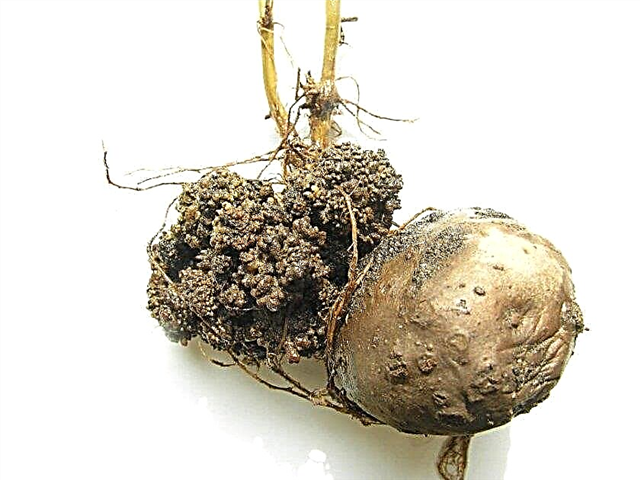
- Scab. The tubers are covered with a mold-like coating. The area surrounding the potato eyes is covered with flaky tubercles. Preventive measures: treatment of tubers before planting with a 4% solution of Metiram. As a treatment, fertilizing with superphosphate or ammonium sulfate (2 tbsp / m) is carried out.

The main pests that pose a threat to the American are:
- Colorado beetle. A pest of a characteristic species with longitudinal black and yellow stripes on the shell can eat almost all foliage, which leads to the death of the plant. Marigolds or calendula planted along the edges of potato plantings prevent the parasite from appearing. To control the beetle, insecticides, for example, Aktara, are used. The first treatment is carried out when the bush grows to 12 cm, the second - after the bush reaches 18 cm, the third - 3 weeks before harvesting. The solution for processing one hundred parts is prepared in this way: 1.2 kg of the drug is dissolved in 5 l of water.
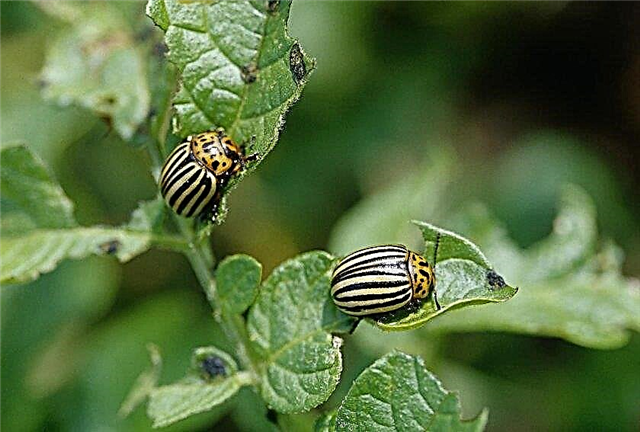
- Bear The fact that the pest has chosen planting of potatoes will be indicated by characteristic cavities in the tubers - traces of eating pulp. As preventive measures, a deep digging of the soil is necessary. To destroy the pest, the bushes are watered with a 0.3% solution of malathion. It is also effective to fill the hole with a solution of vinegar (100 ml / 1 bucket of water).

- Wireworm. The appearance of this parasite can be found in the tubers, already rotting in the ground, and blackened stems. Deep loosening of the soil and removal of weeds are quite effective preventive measures. Destroy wireworm with insecticides. You can apply "Aktara" in the same way (dosage and frequency of treatments), as well as to combat the Colorado potato beetle.
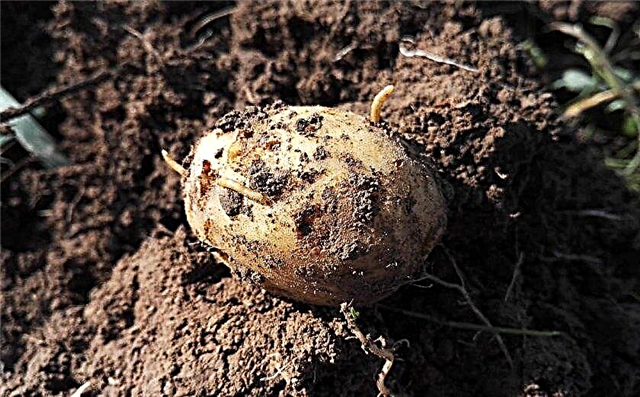
Harvesting and storage
The dry yellowed tops will tell you that it is time to harvest. When the foliage is fresh and green, there is still a lot of chlorophyll in it, metabolic processes take place. As soon as they stop, the leaves turn yellow, then fade and dry.
In different regions and depending on weather conditions, an American can be harvested in the second half of August - the first half of September. About a week before harvesting, you need to mow the tops. For harvesting, you should choose a day when there is no rain, the weather is dry, preferably sunny and windy.
Dug up tubers are laid out along the edge of the garden for drying. Due to ultraviolet irradiation, some microbes die, which contributes to a longer storage of potatoes. In addition, wind-dried land on the surface of a tuber is much easier to remove without damaging the tuber itself.Important! To avoid damage to tubers, it is better to use a pitchfork rather than a shovel when harvesting.
From dried potatoes, the remains of the soil are removed, spoiled, damaged, diseased and rotten tubers are selected. The rest are placed for 5–7 days in a dry, dark place with an air temperature of +12 ... + 15 ° С. After the specified time, they look at the crop again, remove that potato, which may have started to deteriorate, the rest is packed in bags.

To maximize potato shelf life, the following rules must be observed:
- do not store potatoes of different varieties together (in one bag). The shelf life of these varieties can vary significantly in terms of time: that potato, which begins to deteriorate earlier, can provoke damage to other potatoes, with a longer shelf life;
- sort out the crop every 1.5–2 months, remove tubers that are about to begin to deteriorate;
- the first should be used for cooking large tubers or those that were damaged during harvesting;
- For long-term storage, leave small and not fully ripened tubers.
The tubers, which will be set aside for later planting, are left in the air until they turn green. Planting material is stored at a temperature of +2 ... + 4 ° С and air humidity of 80–85%. Potatoes left for storage with subsequent use in food should be stored at the same humidity, but slightly lower temperature - 0 ... + 2 ° С.
Despite all the variety of modern varieties of potatoes, American firmly holds a leading position among consumers and gardeners. Such popularity is due primarily to the excellent taste and marketability of the variety.









